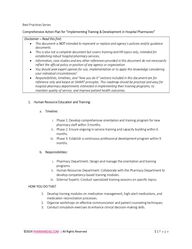
Return to flip book view
©2024 PHARMAREAD.COM | All Rights Reserved 1 | P a g e Best Pracces Series Comprehensive Acon Plan for “Implemenng Training & Development in Hospital Pharmacies" Disclaimer – Read this first: • This document is NOT intended to represent or replace and agency’s policies and/or guidance documents. • This is also not a complete document but covers training and HR topics only, intended for establishing robust hospital pharmacy services. • Information, case studies and any other references provided in this document do not necessarily reflect the official policy or position of any agency or organization. • You should seek expert opinion for use, implementation or to apply this knowledge considering your individual circumstances! • Responsibilities, timelines, and “how you do it” sections included in this document are for reference only and based on SMART principles. This roadmap should be practical and easy for hospital pharmacy departments interested in implementing their training programs, to maintain quality of service, and improve patient health outcomes. 1. Human Resource Educaon and Training: a. Timeline: i. Phase 1: Develop comprehensive orientaon and training program for new pharmacy sta within 3 months. ii. Phase 2: Ensure ongoing in-service training and capacity building within 6 months. iii. Phase 3: Establish a connuous professional development program within 9 months. b. Responsibilies: i. Pharmacy Department: Design and manage the orientaon and training programs. ii. Human Resources Department: Collaborate with the Pharmacy Department to develop competency-based training modules. iii. External Experts: Conduct specialized training sessions on specic topics. HOW YOU DO THIS? 1. Develop training modules on medicaon management, high-alert medicaons, and medicaon reconciliaon processes. 2. Organize workshops on eecve communicaon and paent counseling techniques. 3. Conduct simulaon exercises to enhance clinical decision-making skills.
©2024 PHARMAREAD.COM | All Rights Reserved 2 | P a g e 2. Recruitment and Retenon: a. Timeline: i. Phase 1: Develop recruitment strategies within 3 months. ii. Phase 2: Implement strategies to aract and retain qualied pharmacy sta within 6 months. b. Responsibilies: i. Pharmacy Department: Idenfy stang needs and develop job descripons. ii. Human Resources Department: Manage the recruitment and selecon process. iii. Department Heads: Parcipate in the interview process and provide feedback. HOW YOU DO THIS? 1. Oer compeve compensaon and benets packages. 2. Provide opportunies for professional development and career advancement. 3. Create a posive and supporve work environment. 3. Competency Development: a. Timeline: i. Phase 1: Establish a mechanism for baseline competency assessment within 3 months. ii. Phase 2: Implement periodic competency assessments within 6 months. iii. Phase 3: Conduct appraisal/performance evaluaons within 9 months. b. Responsibilies: i. Pharmacy Department: Develop competency frameworks and assessment tools. ii. Human Resources Department: Coordinate the assessment process. iii. Department Heads: Conduct performance evaluaons and provide feedback. HOW YOU DO THIS? 1. Assess pharmacists' knowledge of medicaon management, paent counseling, and clinical decision-making. 2. Evaluate pharmacists' skills in medicaon reconciliaon, IV preparaon, and sterile compounding. 3. Provide feedback and guidance to help pharmacists improve their competencies.
©2024 PHARMAREAD.COM | All Rights Reserved 3 | P a g e 4. Career Progression Pathways: a. Timeline: i. Phase 1: Dene clear career progression pathways within 3 months ii. Phase 2: Develop procedures for encouraging beer performance within 6 months. iii. Phase 3: Implement formal appreciaon mechanisms within 9 months. b. Responsibilies: i. Pharmacy Department: Design career progression pathways and criteria for advancement. ii. Human Resources Department: Manage the performance evaluaon process. iii. Department Heads: Provide mentorship and support to pharmacy sta. HOW YOU DO THIS? 1. Create opportunies for pharmacists to advance to leadership posions, such as Pharmacy Manager or Clinical Coordinator. 2. Implement a performance-based promoon system that rewards pharmacists for their achievements. 3. Recognize and celebrate pharmacists' contribuons through awards and cercates. 5. Diversity-Sensive Policies and Equitable Deployment: a. Timeline: i. Phase 1: Develop diversity-sensive policies within 3 months. ii. Phase 2: Ensure equitable deployment of pharmacy sta within 6 months. b. Responsibilies: i. Pharmacy Department: Champion diversity and inclusion in the workplace. ii. Human Resources Department: Monitor and address any disparies in sta deployment. iii. Department Heads: Promote a culture of respect and understanding among sta members. HOW YOU DO THIS? 1. Implement policies that prohibit discriminaon based on race, gender, religion, or disability.
©2024 PHARMAREAD.COM | All Rights Reserved 4 | P a g e 2. Ensure that pharmacy sta is equitably distributed across dierent departments and shis. 3. Provide opportunies for pharmacists from diverse backgrounds to parcipate in leadership and decision-making roles. 6. Roles and Responsibilies of Stakeholders in Implementaon: a. Timeline: i. Phase 1: Clearly dene roles and responsibilies within 3 months. ii. Phase 2: Establish eecve communicaon channels within 6 months. b. Responsibilies: i. Pharmacy Department: Lead the implementaon of the roadmap. ii. Human Resources Department: Provide support and guidance to the Pharmacy Department. iii. Department Heads: Collaborate with the Pharmacy Department to ensure successful implementaon. HOW YOU DO THIS? 1. Assign specic responsibilies to pharmacists for orientaon, training, and competency development. 2. Establish regular meengs between the Pharmacy Department and other stakeholders to discuss progress and challenges. 3. Develop a communicaon plan to keep all stakeholders informed about the implementaon process.